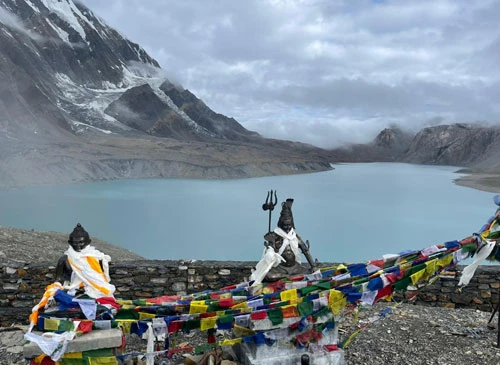Tired of crowded trails and well-trodden paths? The Muldai View Trek is your escape into the untouched beauty of the Annapurna region—a hidden vantage point that rivals even the famous Poon Hill, but with none of the crowds.
Your journey begins along the classic Ghandruk to Tadapani trail. Still, instead of following the usual route, you will veer off the beaten track towards Dobato, where the trail unfolds into a pristine wilderness. As you ascend to Muldai (or Mulde) View Point, you will be rewarded with sweeping panoramic vistas of the Annapurna and Dhaulagiri ranges, uninterrupted, raw, and breathtakingly serene.
This is not just a trek; it is an immersion into the heart of the Annapurna Conservation Area, Nepal’s largest protected wilderness. Here, the air is alive with the calls of rare birds, and if you are lucky, you might spot elusive wildlife like the Himalayan thar or colorful pheasants darting through the rhododendron forests.
With High Adventure Treks, your journey goes beyond the trail. Our expert local guides, who know these mountains like the back of their hand. They will introduce you to the rich Gurung, Magar, and Pun cultures, sharing stories, traditions, and warm hospitality that turn a trek into a true adventure.
We believe in authentic, intimate experiences, no large tour groups, just personalized treks tailored to your pace and curiosity. Whether you are chasing sunrise views from Muldai’s summit or sipping tea in a remote mountain teahouse, every moment is crafted to be unforgettable.
Ready to explore a trail less traveled? Let us guide you to Muldai, where the Himalayas feel like they are yours alone.
Views of the Majestic Mountains
A sunrise that sets the snow-capped giants ablaze in gold. The Annapurna range stretches before you, Dhaulagiri’s icy crown glows in the distance, and Machhapuchhre (Fishtail) pierces the sky like a sacred sentinel. This is Muldai Viewpoint, where the Himalayas don’t just appear; they command awe.
Unlike crowded Poon Hill, Muldai offers uninterrupted, front-row solitude with the world’s highest peaks. As dawn breaks, watch the first light ignite Annapurna South’s razor-edged ridges, spill across the glacier-clad face of Hiunchuli, and finally set Dhaulagiri’s monumental massif aflame. The silence here is profound—no chatter, just the wind carrying the whispers of the mountains.
Mountain Peak | Elevation (m) | Notable Feature |
Dhaulagiri | 8,167 | 7th highest mountain in the world |
Annapurna I | 8,091 | Deadliest, 10th highest; iconic massif |
Annapurna II | 7,937 | Eastern sibling of Annapurna I |
Annapurna III | 7,555 | Sharp, snow-laden ridge |
Gangapurna | 7,455 | Towers above the Sanctuary’s glaciers |
Gurja Himal | 7,193 | Rarely seen, wild, and remote |
Nilgiri Himal | 7,061 | range of 3 peaks in the Annapurna massif |
Machhapuchhre (Fishtail) | 6,993 | Sacred, unclimbed; iconic fishtail shape |
Tukuche Peak | 6,920 | Dominates the Kali Gandaki valley |
Hiunchuli | 6,441 | The 4th-highest trekking peak |
Dhampus Peak | 6,012 | Also called Thapa Peak |
Mulde Viewpoint vs. Ghorepani Poon Hill Trek
The Mulde Viewpoint Trek and Ghorepani Poon Hill Trek both offer breathtaking Himalayan vistas but cater to different trekking styles. Poon Hill is Nepal’s most famous sunrise viewpoint, drawing crowds for its accessible trail and iconic panoramas of Annapurna and Dhaulagiri. However, its popularity means shared sunrises with hundreds of trekkers.
Mulde Viewpoint remains a hidden gem—higher in elevation (3,637m vs. Poon Hill’s 3,210m). It is also far quieter, with wider, more immersive views that include rarely seen peaks like Gurja Himal and Annapurna III. While Poon Hill’s teahouse-lined route is ideal for beginners. Mulde passes through rhododendron forests and remote villages like Dobato and appeals to those seeking solitude and raw Himalayan beauty. Mulde wins for crowd-free sunrises, deeper mountain perspectives, and a true wilderness feel. But Poon Hill remains the classic for convenience and cultural buzz.





